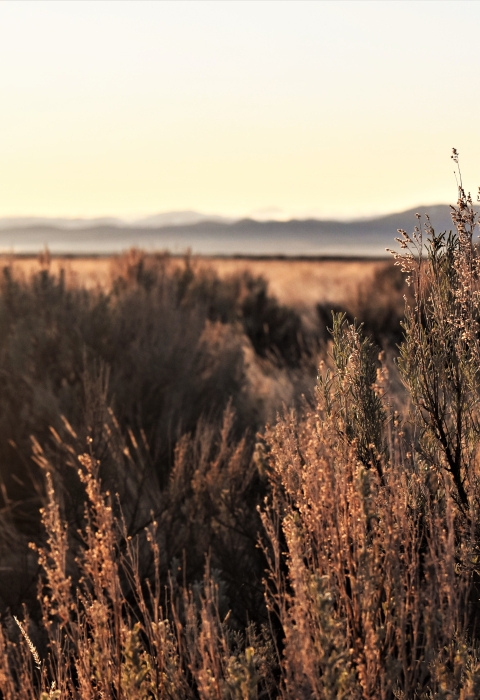WASHINGTON – The U.S. Fish and Wildlife Service today announced $10 million in fiscal year 2023 funds from President Biden’s Bipartisan Infrastructure Law Bipartisan Infrastructure Law
The Bipartisan Infrastructure Law (BIL) is a once-in-a-generation investment in the nation’s infrastructure and economic competitiveness. We were directly appropriated $455 million over five years in BIL funds for programs related to the President’s America the Beautiful initiative.
Learn more about Bipartisan Infrastructure Law to support over 50 projects in western states to restore and conserve strategic areas within the sagebrush ecosystem. These projects will combat invasive grasses and wildfire, reduce encroaching conifers, safeguard precious water resources for neighboring communities and wildlife, and promote community and economic sustainability.
“Sagebrush country, which is a national treasure, supports American agriculture, outdoor recreation, and hundreds of species that live nowhere else in the world,” said Service Director Martha Williams. “This ecosystem serves as the lifeblood for many rural and Tribal communities in the West. We are proud of the work we were able to accomplish last year through the first round of Bipartisan Infrastructure Law funding, and look forward to continuing collaborative efforts to conserve the sagebrush ecosystem and the significant biological, cultural and economic resources it supports.”
Spanning over 175 million acres, sagebrush country contains biological, cultural and economic resources of national significance. It is home to more than 350 species across the West, including pronghorn, elk, mule deer and greater sage grouse. America’s sagebrush ecosystem is the largest contiguous ecotype in the U. S., comprising one-third of the land mass of the lower 48 states.
Through the Bipartisan Infrastructure Law, the U.S. Fish and Wildlife Service was appropriated $10 million per year for five years, to expand work with partners to conserve the sagebrush ecosystem. Projects are helping to create good-paying jobs that strengthen local economies, investing in disadvantaged communities consistent with the President’s Justice 40 initiative, and furthering the strong working relationships between the Department, states and Tribes in these landscapes.
Examples of fiscal year 2023 projects include:
Supporting Idaho's Proactive Invasive Annual Grass Strategy (Idaho), $168,000 – This project will step down and accelerate Idaho's state‐led "Cheatgrass Challenge" and empower regional partnerships to actively manage invasive annual grasses and wildfire threats in sagebrush core habitat in strategic geographies within the state. This project is an exemplar of the larger "Defend the Core" strategy for sagebrush conservation.
Oregon All Counties CCAA Initiative to Protect and Enhance Sagebrush Ecosystems on Private Lands (Oregon), $250,000 – Through the framework of six Candidate Conservation Agreements with Assurances (CCAAs) established with USFWS in 2015, private landowners engage in voluntary sagebrush conservation actions throughout Southeastern Oregon.
Columbia Basin Pygmy Rabbit Recovery (Washington), $209,100 – This project will propagate and release pygmy rabbits (listed as endangered under the ESA and by the state), assist landowners with habitat restoration, and enroll up to 25,000 acres of private land into Safe Harbor Agreements.
See a full list of fiscal year 2023 projects on our Sagebrush Conservation website.
The Service is committed to working with local communities, state and federal agencies, Tribes, conservation groups and private sector partners to ensure they have the tools they need to conserve these important areas. Sagebrush funding is allocated to existing and new projects based on priorities established by the Service’s Sagebrush Ecosystem Team (SET) and partners, including the Western Association of Fish and Wildlife Agencies (WAFWA). The SET, WAFWA and others are employing a collaborative approach to defend and grow intact, functioning sagebrush geographies and mitigate the primary threats to sagebrush ecological health, namely invasive grasses and wildfire, drought and encroaching conifers. By anchoring conservation in these areas, the Service and its partners can focus on working to restore degraded lands and habitat through the “Defend the Core, Grow the Core” approach endorsed by the Western Governors Association.
These projects will help support the America the Beautiful initiative to conserve, connect and restore our nation’s lands, waters and wildlife.
– FWS –
The U.S. Fish and Wildlife Service works with others to conserve, protect, and enhance fish, wildlife, plants, and their habitats for the continuing benefit of the American people. For more information, visit www.fws.gov, or connect with us through any of these social media channels: Facebook, Instagram, Twitter, Flickr, and YouTube.




